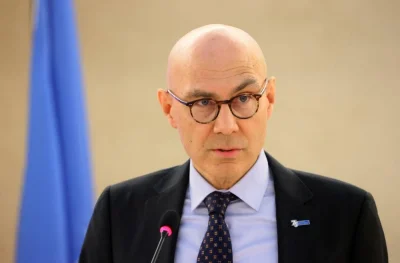Increasingly complex, growing and related risks, from global warming to pollution and epidemics, threaten human survival if left to escalate, the United Nations warned yesterday.
A biennial assessment report on how the world is dealing with disasters said the past could no longer be relied on as a guide to the future, with new risks emerging “in a way that we have not anticipated”. It identified a range of major threats to human life and property, including air pollution, diseases, earthquakes, drought and climate change.
There is also growing potential for one type of disaster to produce or exacerbate another, as when heavy rains trigger mudslides after wildfires, warned the report launched at the Global Platform for Disaster Risk Reduction in Geneva.
“If we continue living in this way, engaging with each other and the planet in the way we do, then our very survival is in doubt,” said Mami Mizutori, special representative of the UN secretary-general for disaster risk reduction.
Extreme weather events have doubled over the last 20 years, causing economic losses that are making it “an uphill battle” to maintain development gains in low and middle-income countries, she added in a statement.
Meanwhile, the ability of both rich and poor to withstand wild weather and other threats is being hurt by poorly planned urbanisation, environmental degradation and population growth.
That “complex cocktail of risk” is destroying homes and displacing people, or pushing them to migrate in search of a better life, Mizutori said.
A report released last week by the Internal Displacement Monitoring Centre (IDMC) showed 1,600 disasters were recorded in 2018, ranging from monsoon floods in India to wildfires in the United States.
The disasters displaced 17.2mn people, some in short-term evacuations, it said.
Since the IDMC began collecting the data in 2008, about 265mn people have been uprooted by disasters, more than three times as many as those forced from their homes by conflicts and violence, it said.
Governments have started to produce data on seven global targets set in the 2015 Sendai Framework, which aims to alleviate disaster risk and impacts.
Those targets focus on reducing mortality, numbers of people affected and economic losses from disasters by 2030 — but progress, while encouraging, is insufficient, Mizutori said.
Ricardo Mena of the United Nations Office for Disaster Risk Reduction (UNDRR) said that of 197 UN member-states, 116 have so far contributed information to a database to monitor the targets.
Mizutori said a little less than half of UN member states had put in place a national strategy for disaster risk reduction — a Sendai target intended to be met by the end of 2020.
She called for stepped-up efforts to craft such plans.
UNDRR’s Global Assessment Report 2019 warned that failure to act more urgently to manage intertwined risks could slow or even reverse progress towards the UN goals on sustainable development, which include eradicating poverty and hunger.
To prevent that happening, more investment is needed to avert disasters and protect vulnerable people from their worst effects, said Mizutori.
The assessment report said development aid used for things such as early warning systems, building stronger schools and hospitals, and helping farmers grow hardier crops in drought-prone areas was “miniscule” compared with funding for disaster response.
About $5.2 bn was spent on reducing disaster risk between 2005 and 2017, representing just 3.8% of total humanitarian spending — or less than $4 for every $100 spent, the report noted.
“We must recognise that an international development financing system that allocates approximately 20 times the funding to emergency response, reconstruction, relief and rehabilitation activities rather than prevention and preparedness acts counter to sustainability principles,” Mizutori said.



